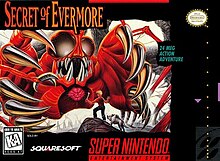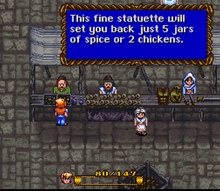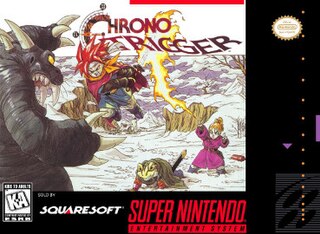
Chrono Trigger is a 1995 role-playing video game developed and published by Square. It was originally released for the Super Nintendo Entertainment System as the first entry in the Chrono series. The game's development team included three designers that Square dubbed the "Dream Team": Hironobu Sakaguchi, creator of Square's Final Fantasy series; Yuji Horii, creator of Enix's Dragon Quest series; and Akira Toriyama, character designer of Dragon Quest and author of the Dragon Ball manga series. In addition, Takashi Tokita co-directed the game and co-wrote the scenario, Kazuhiko Aoki produced the game, while Masato Kato wrote most of the story. The game's plot follows a group of adventurers who travel through time to prevent a global catastrophe.
Square Co., Ltd. was a Japanese video game development studio and publisher. It was founded in 1986 by Masafumi Miyamoto, who spun off part of his father's electronics company Den-Yu-Sha. Among its early employees were designers Hironobu Sakaguchi, Hiromichi Tanaka, Akitoshi Kawazu and Koichi Ishii, artist Kazuko Shibuya, programmer Nasir Gebelli, and composer Nobuo Uematsu. Initially focusing on action games, the team saw popular success with Final Fantasy in 1987. A role-playing video game, it became the first in a franchise of the same name. Later notable staff included directors Yoshinori Kitase and Takashi Tokita, designer and writer Yasumi Matsuno, artists Tetsuya Nomura and Yusuke Naora, and composers Yoko Shimomura and Masashi Hamauzu.

Dr. Mario is a 1990 puzzle video game developed and published by Nintendo for the Nintendo Entertainment System, Famicom, and Game Boy. It was produced by Gunpei Yokoi and designed by Takahiro Harada. The soundtrack was composed by Hirokazu Tanaka.
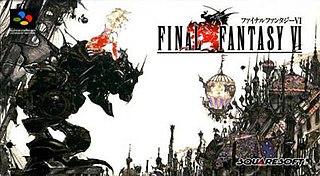
Final Fantasy VI, also known as Final Fantasy III from its initial North American release, is a 1994 role-playing video game developed and published by Square for the Super Nintendo Entertainment System. It is the sixth main entry in the Final Fantasy series, the final to feature 2D sprite based graphics, and the first to be directed by someone other than series creator Hironobu Sakaguchi; the role was instead filled by Yoshinori Kitase and Hiroyuki Ito. Long-time collaborator Yoshitaka Amano returned as character designer and concept artist, while composer Nobuo Uematsu returned to compose the game's score, which has been released on several soundtrack albums.

Final Fantasy Adventure, known in Japan as Seiken Densetsu: Final Fantasy Gaiden or simply Seiken Densetsu, and later released in Europe as Mystic Quest, is an action role-playing video game developed and published by Square for the Game Boy. It is a spin-off of the Final Fantasy series and the first game in the Mana series.
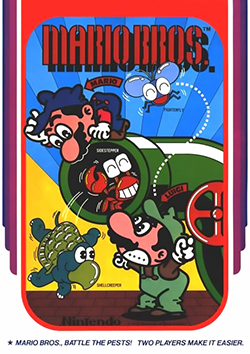
Mario Bros. is a platform game developed and published by Nintendo as an arcade video game in 1983. It was designed by Shigeru Miyamoto and Gunpei Yokoi, Nintendo's chief engineer. Italian twin brother plumbers Mario and Luigi exterminate creatures, like turtles (Koopas) and crabs emerging from the sewers by knocking them upside-down and kicking them away. The Famicom/Nintendo Entertainment System version is the first game produced by Intelligent Systems. It is part of the Mario franchise, but originally began as a spin-off from the Donkey Kong series.

Super Mario World, known in Japanese marketing as Super Mario World: Super Mario Bros. 4, is a platform game developed by Nintendo EAD and published by Nintendo for the Super Nintendo Entertainment System (SNES). It was released in Japan in 1990, North America in 1991 and Europe and Australia in 1992. The player controls Mario on his quest to save Princess Peach and Dinosaur Land from the series' antagonist Bowser and the Koopalings. The gameplay is similar to that of earlier Super Mario games; players control Mario through a series of levels in which the goal is to reach the goalpost at the end.
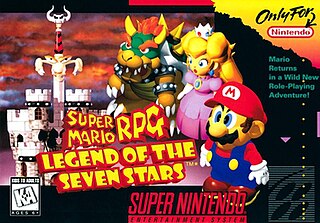
Super Mario RPG: Legend of the Seven Stars is a 1996 role-playing game developed by Square and published by Nintendo for the Super Nintendo Entertainment System (SNES). It was the final Mario game published for the SNES. The game was directed by Chihiro Fujioka and Yoshihiko Maekawa, produced by Shigeru Miyamoto, and scored by Yoko Shimomura.
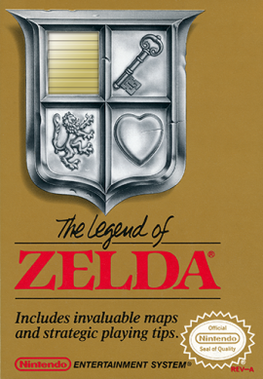
The Legend of Zelda, originally released in Japan as The Hyrule Fantasy: Zelda no Densetsu, is an action-adventure game developed and published by Nintendo. The first game of The Legend of Zelda series, it is set in the fantasy land of Hyrule and centers on an elf-like boy named Link, who aims to collect the eight fragments of the Triforce of Wisdom in order to rescue Princess Zelda from Ganon. The player controls Link from a top-down perspective and navigates throughout the overworld and dungeons, collecting weapons, defeating enemies and uncovering secrets along the way.

The Legend of Zelda: A Link to the Past is an action-adventure game developed and published by Nintendo for the Super Nintendo Entertainment System. It is the third game in The Legend of Zelda series and was released in 1991 in Japan and 1992 in North America and Europe.

The Mana series, known in Japan as Seiken Densetsu, is a high fantasy action role-playing game series created by Koichi Ishii, with development formerly from Square, and is currently owned by Square Enix. The series began in 1991 as Final Fantasy Adventure, a Game Boy handheld side story to Square's flagship franchise Final Fantasy. The Final Fantasy elements were subsequently dropped starting with the second installment, Secret of Mana, in order to become its own series. It has grown to include games of various genres within the fictional world of Mana, with recurring stories involving a world tree, its associated holy sword, and the fight against forces that would steal their power. Several character designs, creatures, and musical themes reappear frequently.

Secret of Mana, originally released in Japan as Seiken Densetsu 2, is a 1993 action role-playing game developed and published by Square for the Super Nintendo Entertainment System. It is the sequel to the 1991 game Seiken Densetsu, released in North America as Final Fantasy Adventure and in Europe as Mystic Quest, and it was the first Seiken Densetsu title to be marketed as part of the Mana series rather than the Final Fantasy series. Set in a high fantasy universe, the game follows three heroes as they attempt to prevent an empire from conquering the world with the power of an ancient flying fortress.

Mode 7 is a graphics mode on the Super Nintendo Entertainment System video game console that allows a background layer to be rotated and scaled on a scanline-by-scanline basis to create many different depth effects. It also supports wrapping effects such as translation and reflection.
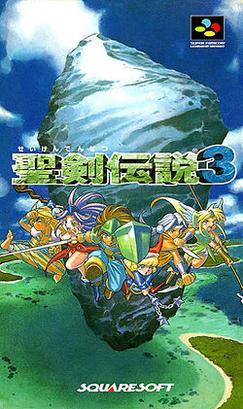
Trials of Mana, also known by its Japanese title Seiken Densetsu 3, is a 1995 action role-playing game developed and published by Square for the Super Famicom. It is the sequel to the 1993 game Secret of Mana, and is the third installment in the Mana series. Set in a high fantasy world, the game follows three heroes as they attempt to claim the legendary Mana Sword and prevent the Benevodons from being unleashed and destroying the world. It features three main plotlines and six different possible main characters, each with their own storylines, and allows two players to play simultaneously. Trials of Mana builds on the gameplay of its predecessor with multiple enhancements, including the use of a time progression system with transitions from day to night and weekday to weekday in game time, and a wide range of character classes to choose from, which provides each character with an exclusive set of skills and status progression.
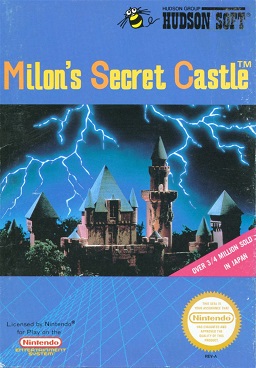
Milon's Secret Castle, known in Japan as Meikyū Kumikyoku: Milon no Daibōken, is a 1986 action-adventure game released by Hudson Soft for the NES. A Game Boy version was released in 1993. A sequel, DoReMi Fantasy, was released in 1996 for the Super Famicom.
The Nintendo Player’s Guides are a series of video game strategy guides from Nintendo based on Nintendo Power magazine.
Nasir Gebelli is an Iranian-American programmer and video game designer usually credited in his games as simply Nasir. Gebelli wrote Apple II games for Sirius Software, created his own company Gebelli Software, and worked for Squaresoft. He became known in the early 1980s for producing fast action games for the Apple II, including 3D shooters.
The Mana series, known in Japan as Seiken Densetsu, is a role-playing video game series from Square Enix, created by Koichi Ishii. The series began as a handheld side story to Square's flagship franchise Final Fantasy, although most Final Fantasy-inspired elements were subsequently dropped, starting with the second installment, Secret of Mana. It has since grown to include games of various genres within the fictional world of Mana. The music of the Mana series includes soundtracks and arranged albums of music from the series, which is currently composed of Final Fantasy Adventure and its remake Sword of Mana, Secret of Mana, Trials of Mana, Legend of Mana, Dawn of Mana, Children of Mana, Friends of Mana, Heroes of Mana, Circle of Mana, and Rise of Mana. Each game except for Friends and Circle has produced a soundtrack album, while Adventure has sparked an arranged album as well as a combined soundtrack and arranged album, Legend of Mana has an additional promotional EP, and music from Secret and Trials were combined into an arranged album. For the series' 20th anniversary, a 20-disc box set of previously-released albums was produced, as well as an album of arrangements by Kenji Ito, composer for several games in the series.

Super Adventure Island II is a Super NES video game by Hudson Soft. Unlike most of the previous games, it is a platformer with action-adventure elements that encourages exploration, similar to the later Wonder Boy games.
The 1990s was the third decade in the industry's history. It was a decade of marked innovation in video gaming. It was a decade of transition from sprite-based graphics to full-fledged 3D graphics and it gave rise to several genres of video games including, but not limited to, the first-person shooter, real-time strategy, survival horror, and MMO. Arcade games, although still very popular in the early 1990s, began to decline as home consoles became more common. The fourth and fifth generation of video game consoles went on sale, including the Sega Genesis, Super Nintendo, Sega Saturn, PlayStation, Nintendo 64, and Game Boy Color. Notable games released in the 1990s included Super Mario World, Sonic the Hedgehog, Street Fighter II, Mortal Kombat, Killer Instinct, Tekken,Doom, Wolfenstein 3D, Quake, Duke Nukem 3D, Final Fantasy VII, Unreal Tournament, Star Fox, Half-Life, Grand Theft Auto, Super Mario 64, Pokémon Red and Blue, NBA Jam,Daytona USA, GoldenEye 007, System Shock 2, Civilization,Ridge Racer, Sonic Adventure, Gran Turismo, Super Mario Kart, Pokémon Gold and Silver,Castlevania: Symphony of the Night, Super Metroid, Silent Hill, The Legend of Zelda: Ocarina of Time, Crash Bandicoot, Spyro The Dragon, Fallout, Metal Gear Solid, Diablo, Virtua Fighter, Tomb Raider,Sega Rally Championship, Wing Commander,Super Smash Bros, Secret of Mana,Thief: The Dark Project, Age of Empires, Nights into Dreams, Panzer Dragoon, Gunstar Heroes, EverQuest, Chrono Trigger, Battletoads, Worms, Myst, Micro Machines, Streets of Rage 2,Baldur's Gate,Donkey Kong Country, Wipeout, The Legend of Zelda: A Link to the Past,Lemmings, EarthBound, StarCraft, Banjo-Kazooie, PaRappa the Rapper, Resident Evil, Tony Hawk's Pro Skater, Soulcalibur, Command & Conquer, and Dance Dance Revolution.
